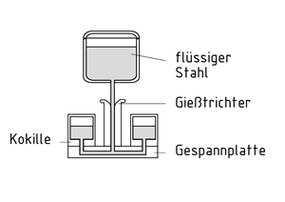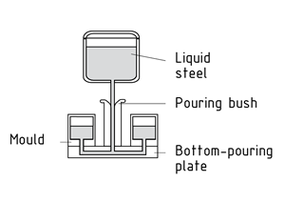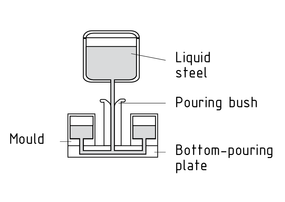
Seleccione uno
o más idiomas
0,1,3
- Alemán
- Inglés
- Chino
- Español
Fundición de lingotes

En las fundiciones metalúrgicas de lingotes, se usan usualmente moldes de hierro fundido permanentes para producir lingotes, placas o tochos que son posteriormente procesados en productos semiterminados (usando procesos de conformado como el prensado, enrollado o embutido) o piezas brutas (por medio del forjado o prensado). Posteriormente, la forma y las dimensiones de la fundición ya no se asemejan al lingote original.
Se debe distinguir entre la fundición superior, en la cual el metal fundido es vaciado en moldes de arriba hacia abajo, y la fundición inferior, en la cual el molde se llena de abajo hacia arriba. El proceso de llenado de varios moldes de abajo hacia arriba se conoce como fundición de grupo y requiere un sistema de distribución. Los moldes se llenan en un foso de fundición.
Una vez que el metal derretido se solidifica, los moldes son removidos de los lingotes.
Disposición de muestra de una fundición inferior
Blockgießverfahren

Beim metallurgischen Blockgießverfahren werden meist in Dauerformen aus Gusseisen (Kokillen) Blöcke, Brammen und Barren hergestellt, die später durch Umform-Techniken wie Pressen, Walzen und Ziehen zu Halbzeugen bzw. beim Schmieden oder Pressen zu Rohteilen weiterverarbeitet werden. Das Gussteil gleicht in Gestalt und Abmessungen anschließend dem ursprünglichen Block nicht mehr.
Unterschieden werden Kopfguss bzw. fallender Guss, bei dem metallische Schmelze von oben in die Form eingegossen wird, oder der Bodenguss, bei dem die Kokille von unten gefüllt wird. Das Füllen mehrerer Kokillen von unten wird Gespannguss genannt, für den ein Verteilersystem nötig ist. Die Kokillen werden in der Gießgrube gefüllt.
Nach dem Erstarren der Schmelze werden die Kokillen von den Blöcken entfernt.
Ingot casting

In metallurgical ingot casting, permanent cast-Iron moulds are usually used to produce ingots, slabs or billets that are later processed into either semi-finished products (using Forming processes such as pressing, Rolling and drawing) or blanks (by means of Forging or pressing). Afterwards, the shape and dimensions of the Casting no longer resemble the original ingot.
A distinction is made between top casting, in which the metallic melt is poured into the mould from above, and bottom casting, in which the mould is filled from below. The process of filling several moulds from below is known as group casting and requires a distribution system. Moulds are filled in the casting pit.
Once the melt has solidified, the moulds are removed from the ingots.
铸锭

在冶金铸锭工艺中,通常将熔化的金属倒入永久铸铁模具中来制造铸块、板坯或方坯,然后将其加工成半成品(通过如压制、轧制和拉制等成型工艺)或毛坯(通过锻造或压制方式)。原锭经加工之后形成的铸件,形状和尺寸发生了变化。
可根据熔化金属的浇注位置分为顶注式和底注式铸造。几个铸模的底注式铸造过程被称为底铸,并且需要均温系统。铸模在铸锭坑中进行。
一旦熔化金属凝固,将铸块从模具中取出。
底注式铸造的样品设置
